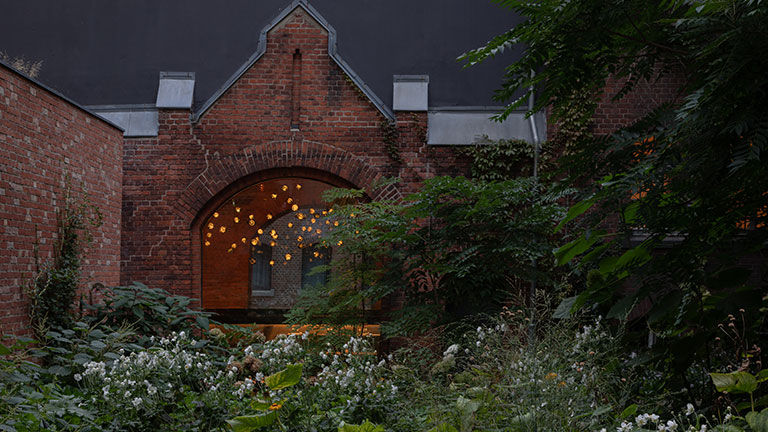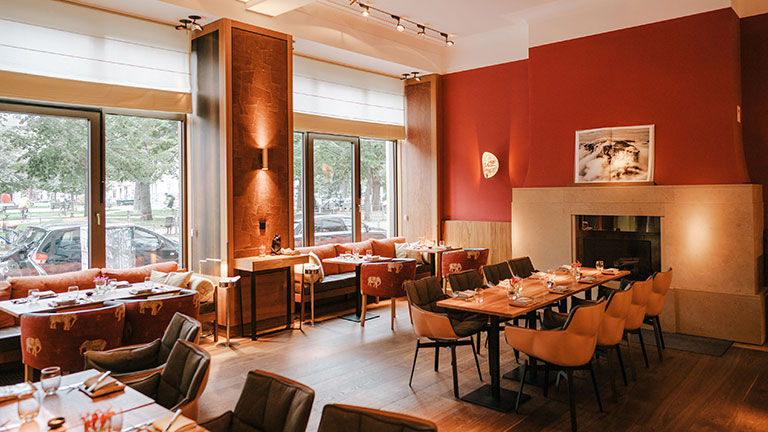Berlin’s 20th century was more fraught than many, though that is when the city discovered many of the simple, but hearty foods that are now emblematic as local favorites.
Visitors to Berlin are bound to try a currywurst from a street vendor (or from room service at The Ritz-Carlton, Berlin, like I did, jetlagged at 3 a.m.).
Flash-fried German sausage that’s sliced and presented in a paper boat with a generous helping of curry-spiked ketchup and curry powder — served with a tiny wooden cocktail fork, and often French fries — was invented just after World War II and has been a Berlin tradition ever since.
The early 21st century brought an explosion of culinary creativity, and Berlin’s food scene is a chief benefactor. International cuisine continued to grow in prominence as the city saw growth in its immigrant communities. One tasty example is the Turkish doner kebab (rotisserie-cooked meat), popularized in the 1970s. Berlin’s food scene also started to be dominated by a focus on eco-friendly sourcing, and creatively adapted dining spaces.
Best Restaurants in Berlin: Lovis Restaurant
In the homey, un-touristy Charlottenburg district, Lovis Restaurant turns out contemporary German cuisine as part of the Wilmina hotel.
In a space that was once a courthouse and a women’s prison — some of the iron bars have been retained among the brickwork for effect — the kitchen serves gastronomic fare with a focus on local produce in season. The city is surrounded by rich, rain-soaked farmland, and is near the Baltic Sea, so there’s no shortage of fresh vegetables and fresh seafood to provision the city’s restaurant larders.
 Lovis Restaurant is located in a space that was once a courthouse and a women’s prison.
Lovis Restaurant is located in a space that was once a courthouse and a women’s prison.
Credit: 2022 WilminaHelmed by a female chef, the cooking at Lovis is produced from those same earthy mitteleuropa (Middle Europe) ingredients — wild garlic, asparagus, leeks and rhubarb, for example — that have long figured in German cuisine, elevated with mastery of craft and artful presentation.
Gastro Rallye Tours Take Berlin Foodies to Bless, Terz and Restaurant Volt
On the similar theme of “local, but not typical,” Gastro Rallye offers food tours that are more like progressive dinners, which steer guests toward buzzy, local restaurants selected for diversity and innovation.
On a recent tour, the evening started with appetizers at the immigrant-owned Bless in Mitte, where I enjoyed the bold flavors of northern Vietnamese cooking with some artful twists, such as an Indochinese version of Korean chicken rolled in crunchy roasted rice flakes and Viet Tacos, a playful update on the banh mi sandwich.
Overhead, the chandeliers are formed from lights inside open antique birdcages — almost in commentary on the nature of emigration. One co-owner arrived in Germany from Vietnam on his own at the age of 16 and got started in the food industry by washing dishes; the other recalls sharing a single room with four family members in an asylum camp, sleeping under the dining table with his guinea pig.
The next stop was the Neukolln district of Berlin, in a quiet neighborhood circle surrounding a church. Terz repurposes a side building of the church in a light, high-ceilinged space with a large outdoor terrace. By day, it is a coffee shop with a large selection of sandwiches, pastries and cakes. By night, the restaurant produces dinners with local produce and biodynamic wines. There are selections of small and large plates (each with a vegan option) such as char with mustard greens and black garlic or green asparagus with a free-range egg and wild herbs.
Michelin-listed Restaurant Volt was the dessert spot for the evening. The eatery is located in what was once a transformer station fronting the Landwehr Canal in the once-gritty Kreuzberg district, which is now seeing more trendy restaurants. These new restaurants are often just a few blocks away from the still rather gritty (read: inexpensive) bars perched above convenience stores and late-night kebab storefronts.
Here, diners imbibe at tables underneath hulking copper spheres fashioned into chandeliers, and can choose from either a vegan or non-vegan menu, and enjoy an impressive wine list. For our tour, desserts arrived with inventive flavors, such as marigold and earl grey ice creams, chocolate and hazelnut creams scented with coffee and tangy fruit jellies paired with dessert wines.
Orania.Restaurant
Also in Kreuzberg, the restaurant at the luxury Hotel Orania has become known for its Peking Duck for Two. That experience starts off with duck dashi soup and dim sum, after which the duck is brought whole to the table and the rich skin is carved off and served with cucumber, a pancake and hoisin sauce.
 Orania.Restaurant is at the upscale Hotel Orania.
Orania.Restaurant is at the upscale Hotel Orania.
Credit: 2022 Mario HellerThe breast is brought back to the kitchen to be carved and then returned to the table, sliced with bok choy; it’s all capped off with duck fried rice crowned with a silky egg yolk. There’s also a “vuck” version for vegetarians with mushroom dashi, Szechuan eggplant and vegetarian fried rice.
Many of the restaurants have seasonal rotating menus, while Bless and Orania have slightly more consistent menus. Reservations for many restaurants in Berlin can be essential, particularly closer to weekends. Otherwise, visitors can sit back and enjoy the fruits of Berlin’s burgeoning, creative culinary scene.